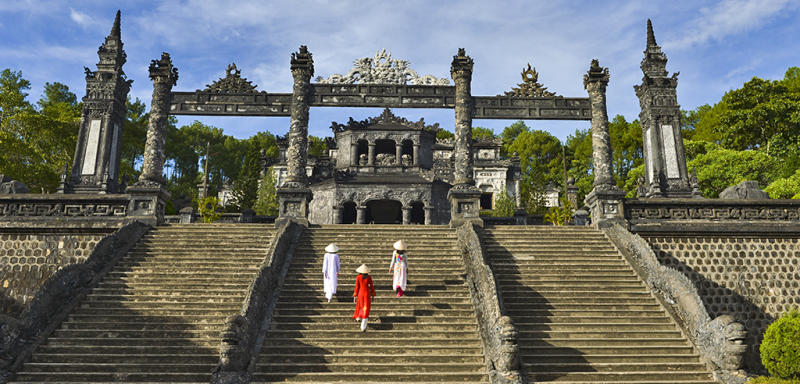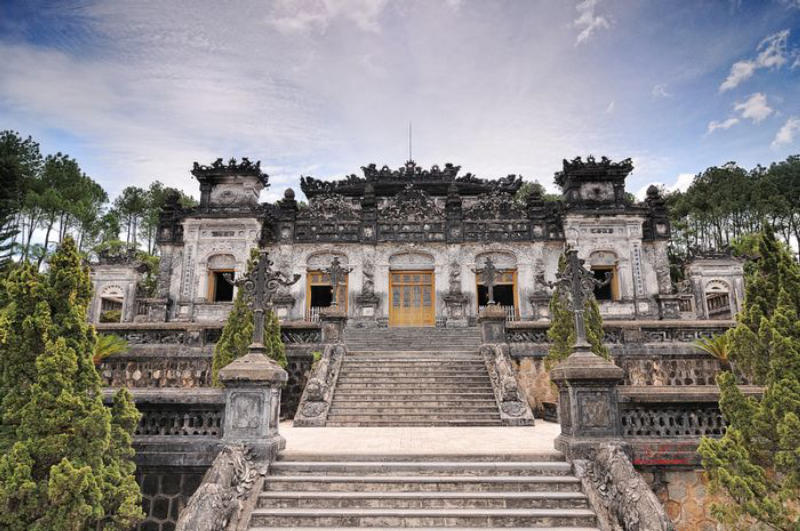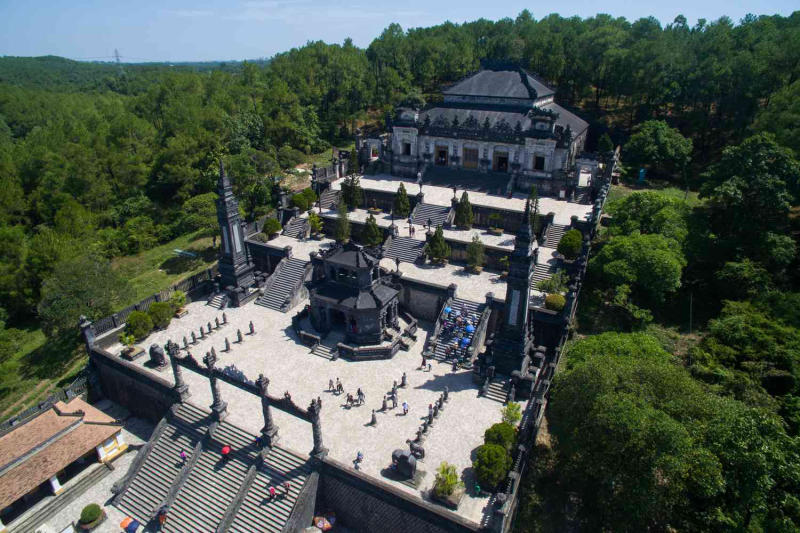Khai Dinh Tomb (also known as Ung Tomb) is one of the must-see landmarks in the imperial city of Hue. This fusion of intricate craftsmanship and reflection of the rich history will give you an unforgettable experience.
So, how captivating is Khai Dinh Tomb, to be exact? And how can you enjoy its timeless beauty in full? Dive into this detailed guide by Vietnamtour.in and prepare to be mesmerized by this time-honored complex.
Exploring The Complicated History of Khai Dinh Tomb
This complex was built in the early 20th century. It served as the final resting place for Khai Dinh – Vietnam’s last emperor (1916-1925). This is a controversial figure because of his close collaboration with French colonizers, which also made him viewed as a French puppet.

Vietnamese kings often planned to build a monument for themselves, and so did Khai Dinh in spite of his unpopularity. Construction began in 1920 and was not completed until 1931, under the reign of Bao Dai – Khai Dinh’s successor. As controversial as the king, his mausoleum took a long time to construct and hinged upon the 30% increase in the national tax.
The Awe-inspiring Architectural Fusion of Khai Dinh Tomb
The Tomb stands out with its rectangular shape, which is different from traditional Vietnamese Tombs. This is the result of Khai Dinh’s impression of French culture from his trip. So, the construction reflects a unique blend of Eastern and Western aesthetics, which showcases evidence of French influence in slate and wrought iron materials. Besides, visitors can find hints of Indian, Buddhist, Roman, and Middle-aged styles throughout the complex.

The exterior features distinctly gray, weathered concrete, but the real surprise lies within. Step inside, and you will be greeted by an explosion of colorful ceramic mosaics and the largest dragon sculptures ever seen in Vietnam.
Besides, you will discover a biography of Khai Dinh and an abundance of carvings depicting figures and animals, surpassing those found in other Tombs of the Nguyen Kings.
Location
Khai Dinh tomb is located in Chau Chu Village, Thuy Bang Commune, Huong Thuy District, Hue City. Khai Dinh Tomb is located on Chau Chu Mountain, just around 10 kilometers from the city center.
This feng shui-oriented location harmonizes with the surrounding natural environment, offering a visually stunning landscape to enhance your journey.
Opening Hours And Ticket Fee
- Opening hours: 7:00 am – 5:30 pm daily
- Entrance fee: 150.000 VND/adult (approximately $5.9) and 30.000 VND/child (approximately $1.2)
How to get there
Thanks to its convenient location, you can choose among different ways to arrive at the Tomb of Khai Dinh:
- By bus: Those seeking a cost-effective option can take the bus that heads to Dong Ba – Cho Tuan. This route includes a stop at the Khai Dinh Tomb.
- By taxi: If you prefer a hassle-free option, choose a taxi which takes only 15 to 20 minutes
- By car: If you drive from the city center, head to Dien Bien Phu/D.Khoi Street to the southwest. Then, join Minh Mang Street until you reach Khai Dinh Street. Khai Dinh’s Tomb is located nearly at the end of this route.
Best Time To Visit
Travelers recommend visiting Hue during summer as there tends to be less rainfall. However, with the rising global temperature, wandering around Hue during these months is quite hot and tiring. So, if possible, start your trip in January or February when the weather is more pleasant, making your adventure much more comfortable.
What To See When Visting Khai Dinh Tomb
The mausoleum of Emperor Khai Dinh has 127 stairs, which lead to different sections within its complex. Let’s explore a bit further!
Experience The Grandeur of Tam Quan Gate
Tam Quan Gate is on the first floor of the Tomb and houses two major works: Ta Tong Tu and Huu Tong Tu. To reach it, you must take the first 37 of the mausoleum’s 127 stairs!

The gate is named Tam Quan because it was intended for mandarins and kings. The right and left gates are for mandarins, and the center entrance is for the emperor. Here, you will be impressed by the harmony of Vietnamese and Indian cultures with their Hindu-inspired design.
Explore The Imposing Nghi Mon Gate
It takes another 29 stairs from Tam Quan Gate to Nghi Mon Gate. Here, you will explore a grand display of life-sized statues crafted from bluestone, standing proudly on the Bai Dinh Yard. There are 24 figures in total, outnumbering similar statues at any other mausoleum.

These standing statues consist of royals, warriors, even horses and elephants. They serve as the emperor’s court and continue serving him in the afterlife, just as they did when he was alive. One interesting thing is that each of them has a unique facial expression.

Wander Through The Solemn Of The Stele Pavilion
The heart of the Nghi Mon Area features a unique octagonal gazebo. You will easily realize it when you bypass the gate.

Inside this gazebo, there is a massive 10-ton stele, which is impressively 3.1 meters tall. This stele, known as Bi Dinh of Ung Mausoleum, serves as a monument to Khai Dinh’s life and accomplishments. Interestingly, it was commissioned by his successor, Emperor Bao Dai.
Find The Secret Behind The Tru Bieu Pillars
Two impressive buildings called Bieu pillars stand on either side of the Stele pavilion. The design of these pillars was influenced by Buddhist stupa architecture. There is a special meaning behind the Tru Bieu: A pair of illuminated candles that guided Khai Dinh’s soul when he was in the afterlife.

Immerse Yourself In The Remarkable Structure of Thien Dinh Palace
As you cross the Bai Dinh yard, you will see the Thien Dinh palace – the highest part of the Khai Dinh Tomb and the king’s final resting place.
Thien Dinh Palace stands out for its innovative architecture and exquisite artistry. Prepare to be impressed by the marble floor and porcelain walls adorned with intricate and beautiful bas-reliefs.

Below the gold-flecked canopy, explore the giant golden statue of King Khai Dinh. And approximately 18 meters below the statue, there is the most exquisite feature of Thien Dinh Palace – the royal crypt.
Attractions Nearby
Beyond the Khai Dinh Tomb, Hue has an endless list of historical and cultural attractions. Here are some popular names that attract Indian tourists every year:
- Hue Imperial City: Explore the UNESCO World Heritage Site that was the political heart of the Nguyen Dynasty emperors
- Perfume river: Wander along the river and enjoy the beauty of Hue’s local life as well as the picturesque pagodas that line the riverbanks.
- Thien Mu Pagoda: Located atop Ha Khe Hill. this seven-tiered tower is one of the iconic symbols of Hue
- Tu Duc Tomb: Enjoy the picturesque setting and elaborate architecture of Tu Duc Tomb, which is surrounded by tranquil gardens and courtyards
>> Read more: Top 10 Best Places to Visit in Hue for Indian Tourists
Tips When Visiting Khai Dinh Tomb
- Wear modest clothing and comfortable shoes
- Bring a hat, sunscreen, and water
- Follow any posted rules and restrictions
- Respect the historical site and be careful with all artifacts
- Keep the area clean
- Consider going with a local guide for a deeper understanding of the tomb’s history
Wrapping Up
Khai Dinh Tomb is a perfect destination for Indian tourists who are looking to explore the history of Hue Imperial City. The complex promises an unforgettable experience for you and your family, given its unique architecture and harmonious location. So, book Vietnam tours with Vietnamtour.in, and our dedicated local guide will help you plan the best trip ever!
OTHER ATTRACTIONS IN HUE








